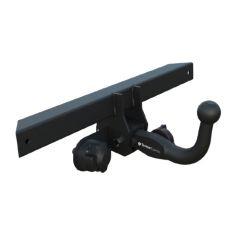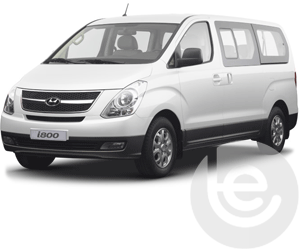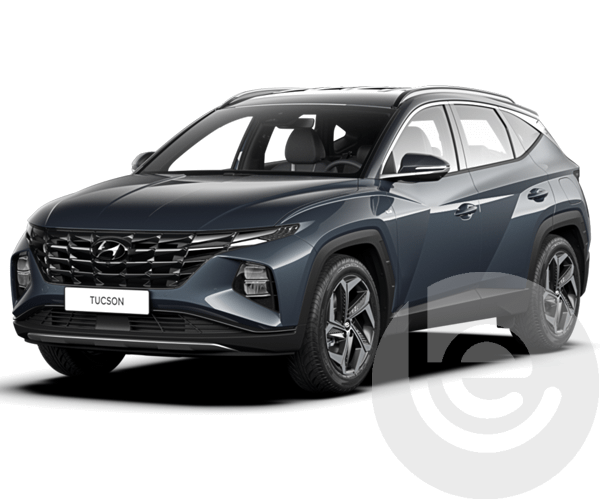More about the Hyundai Santa Fe
No matter the weather conditions, the Hyundai Sante Fe quickly switches between drive modes to suit conditions and even your mood. The sport mode allows for enhanced performance with modified throttle response, shift points and steering effort. The ECO mode delivers peak fuel efficiency with modified acceleration, shift points and air conditioning performance. The comfort mode provides a more regular performance with good efficiency. Snow mode is the perfect feature that optimises control by minimising wheel slip in slippery and snow-covered road conditions; this is done by adjusting engine torque, gear shift pattern, traction control and all-wheel drive torque distribution. The Sand mode works with the engine torque to provide a smooth take-off and performance to drive soft and high-resistant road conditions.
The traction control and all-wheel drive torque distribution optimise the perfect driving experience. Finally, the mud mode optimises relevant performance to drive in slippery and high-resistance road conditions. This is done by adjusting engine torque, gear shift pattern, traction control and all-wheel drive torque distribution.
Cutting-edge connectivity comes naturally to the Sante Fe; upgrading the intelligent technology has allowed users to enjoy smartphone mirroring and advanced connectivity featuring Bluelink Connected car services. This allows the driver to control the Hyundai Sante Fe from your smartphone or even by using your voice.

What's my Towing Capacity?
The Hyundai Sante Fe has a towing capacity of around 2500KG; this generous capacity allows the driver to tow a cycle carrier, trailer and a medium-sized caravan. To find an accurate towing capacity for your Hyundai Sante Fe, please refer to the VIN plate located under the bonnet or the passenger door sill.
Which Towbar is best for my Santa Fe?
Three styles of towbars are available for the new Hyundai Sante Fe: the fixed swan neck, the fixed flange towbar, and the detachable swan neck towbar.
The fixed flange towbar is a permanent style of Towbar that is fixed onto the vehicle's chassis and cannot be removed at the end of towing. The fixed flange towbar is a small chunky towbar; it is the only style towbar equipped with a plate on the rear that allows towing accessories to be attached simultaneously to towing with the towball.
The fixed flange towbar is compatible with all styles of cycle carriers, trailers and caravans. The fixed flange would require an ALKO style towbar if towing a caravan with an ALKO style stabiliser.
The fixed swan neck is another style of permanent Towbar; the swan neck style is a much thinner neck meaning it is much less likely to cause interference with rear parking sensors. The fixed swan neck towbar is compatible with all clamp-on style towbars, trailers and caravans. Unlike the fixed flange towbar, the fixed swan neck towbar can tow a caravan with an ALKO stabiliser without needing a detachable swan neck towbar.
The detachable swan neck towbar is the only style that the neck can be removed once towing has been completed. The detachable swan neck has a lock and key for security; the neck is easily removed using a twist and lock method. The detachable swan neck is compatible with all clamp-on styles of cycle carriers, caravans and trailers. The detachable swan neck also doesn't need an ALKO towball when towing a caravan with an ALKO Stabiliser.
Will it need a bumper cut?
When fitting any towbars to the Hyundai Sante Fe 2021 onwards model, the bumper is removed during fitment, but no modifications will be made. The bumper will be refitted once the towbar installation has been completed. If your Hyundai Sante Fe has been modified or doesn't have the standard bumper, the towbar engineer may need to make alterations to the bumper. All modifications will be discussed before the towbar fitment commences.
How do I book a Towbar Fitment?
We know our customers lead busy lives, which is why our Engineers will come to your home or your place of work. You can choose whether you want your appointment to be in the morning between 8 am and 12 pm or in the afternoon between 12 pm and 6 pm. Our team will fit your Towbar at a time that’s convenient to you. Our towbar fitting service can take as little as one hour and up to four hours, depending on your vehicle.
To get a quote, all you need to do is search for your vehicle below or enter your registration number and postcode above. You can book your date, time, and location online, and we will take care of the rest. We will bring everything needed to complete the job in one appointment. If you order any Cycle Carriers or accessories with your Towbar, the Engineer will also bring those to the appointment.
Why choose Towbar Express?
Towbar Express have over 30 years of experience in the industry, and we know exactly what you need! We employ all our Towbar Engineers, so we won’t just contract out the work to a 3rd party company. They are all trained to a high standard, and training is carried on throughout their employment with us to ensure they understand every aspect of every vehicle. New vehicles are released every year, and our Engineers are trained, and their knowledge is updated constantly.
We have thousands of Trustpilot and Google reviews from customers who have taken their time to send us their feedback! We appreciate every single one of them and thank them for taking the time to review us!



















